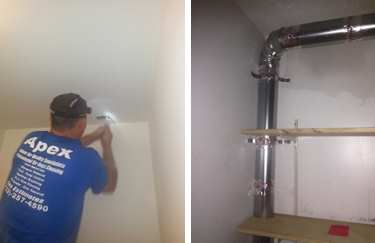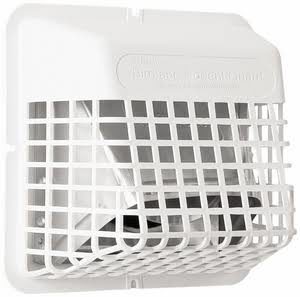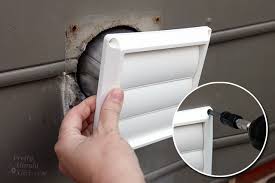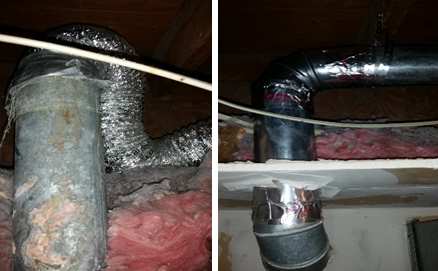The transition hose if the flexible vent that attaches to the back of the dryer and connects to the rigid pipe that leads to the outside. This transition hose is the first defense against a fire spreading to your home. We make sure we use only UL2158 material to ensure your safety. https://dryerflex.com/

If it is discovered that there is a disconnected line in your ceiling or walls, we can fix it on the spot. We use a flexible camera to snake though the system and locate the disconnected pipe. We will mark the location and make a small hole to gain access to the pipe. We will make the repair, clean the lint, and patch the hole.

Birds are a big problem as they like to nest in vents. We can install a bird guard to prevent a bird from nesting in your dryer duct system and possibly causing a fire.


A common problem with dryer vents that travel up the ceiling and into the attic is there is no way of knowing what is going on up there. Too many times when we enter an attic to clean a dryer vent, we find ducts disconnected or not venting to the outside.

Do you know: The shorter the dryer exhaust system, the faster and safer your clothes will dry.
There are several reasons to have to reroute or repair your dryer venting system.
The most common are:
Here is why. A clothes dryer is designed to generate a certain amount of airflow to remove heat, moisture and lint from the inside of the dryer to the outside of the home. The faster it does this, the faster your clothes dry. If your venting system exceeds the recommended designs of the building codes, the airflow is reduced causing the lint and moisture to collect inside of the vent line and eventually cause a clog. This is more prevalent in systems that vents upwards through attics and through the roof.

National Building codes:
504.6 Domestic clothes dryer ducts. Exhaust ducts for domestic clothes dryers shall be constructed of metal and shall have a smooth interior finish. The exhaust duct shall be a minimum nominal size of 4 inches (102mm) in diameter. The entire exhaust system shall be supported and secured in place. The male end of the duct at overlapped duct joints shall extend in the direction of airflow. Clothes dryer transition ducts used to connect the appliance to the exhaust duct system shall be limited to single lengths not to exceed 8 feet (2438 mm) and shall be listed and labeled for the application. Transition ducts shall not be concealed within construction.
504.6.1 Maximum length. The maximum length of a clothes dryer exhaust duct shall not exceed 25 feet (7620 mm) from the dryer location to the outlet terminal. The maximum length of the duct shall be reduced 2.5 feet (762 mm) for each 45-degree (0.79 rad) bend and 5 feet (1524 mm) for each 90-degree (1.6 rad) bend.
Do you need dryer vent cleaning, chimney cleaning or air duct cleaning service? Contact us if you have questions or book a service appointment online.
APEX Home Office:
1331 E Lincoln Hwy Suite 175
Levittown PA 19056
Phone Number: 215-608-2442
Monday – Friday | 9 AM – 5 PM
Saturday | 9 AM – 1 PM
Sunday | Closed